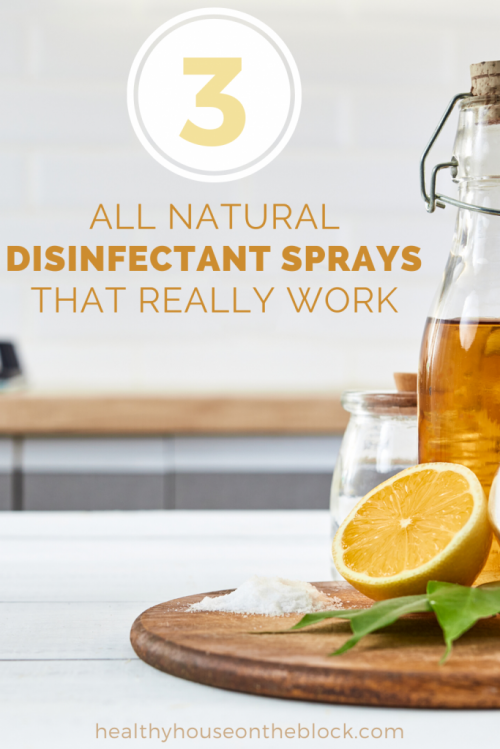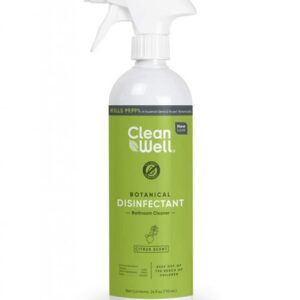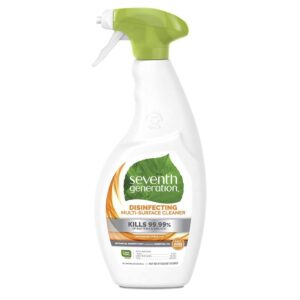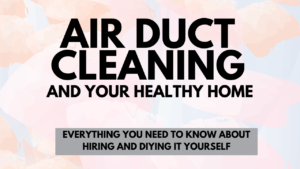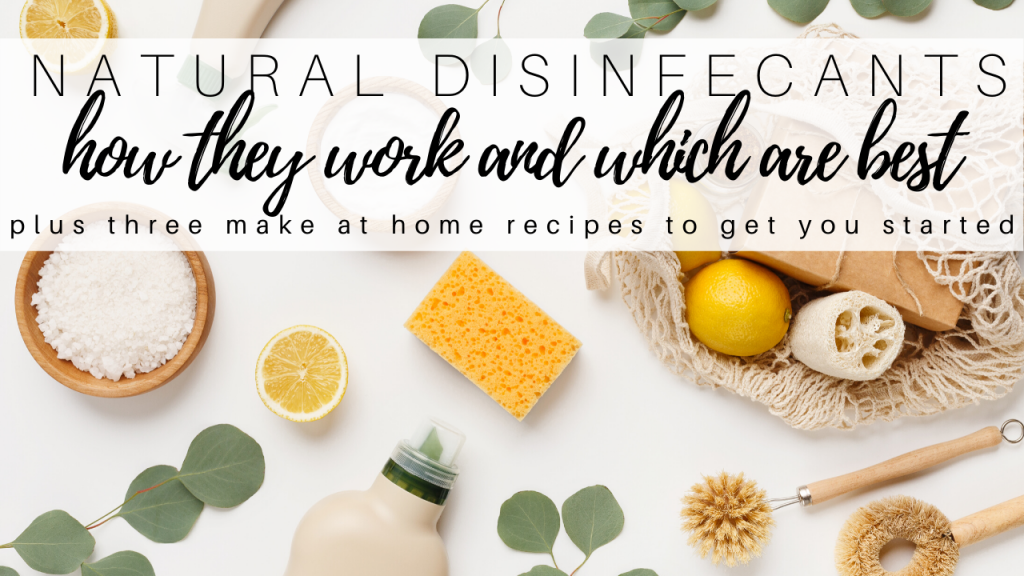
One of the conversations we had in our home as we gradually changed over our lifestyle to be healthier revolved around natural disinfectants. Specifically, the question came up, “Do natural disinfectants really work? Especially when it comes to food safety?” I knew I wanted to change all our cleaning products, and at the time I was in the Lysol Wipe camp, which I had come to realize was really harming our family more than helping. But I had such a difficult time believing that a disinfectant could come from a natural source. It didn’t seem possible.
If you’ve been around my blog for any amount of time, you know that I really love studies and research that proves the benefits or health effects of any particular product or material. I knew that there had to be unbiased research out there as to IF natural disinfectants work and HOW they kill bacteria and viruses. I knew that the chemicals and synthetic fragrances in harsh cleaners were doing a disservice to my family’s health, and I also knew that over-sanitizing was NOT the key to staying healthy.
Which led to another conversation at our house, did we need a disinfectant to kill both bacteria AND viruses? Or did we want something that really focused on kitchen bacteria for when we were handling raw meat, etc? Mind you this was years ago, long before the COVID-19 pandemic came about. So at the time, to me the most important was really focusing on getting a natural disinfectant that would deal with bacteria.
However, as we’ve begun to change some of our home habits with COVID-19 present in our communities, I’ve also looked into a natural disinfectant that kills viruses as well.
So let’s take a look at the variety of natural disinfectants that really do work to kill either bacteria or viruses (and in some cases, both).
WHAT ARE NATURAL DISINFECTANTS AND DO THEY REALLY WORK?
In short, yes, natural disinfectants really do work. The difference often is that they may only work on bacteria rather than on both viruses and bacteria. The other difference with natural disinfectants is that you need to leave them sit wet on a surface for a period of time BEFORE wiping them off (which is actually the case with many synthetic products as well).
Vinegar: Vinegar does have antibacterial properties when it comes to killing food bacteria (such as E.Coli), however it must be used on it’s own or slightly diluted with just water to do this. Mixing vinegar with any other base can cancel out this antibacterial property (STUDY). Vinegar used in the correct way is a really simple natural disinfectant.
Hydrogen Peroxide: A hospital study showed that the disinfecting power of hydrogen peroxide was comparable with the disinfecting properties of bleach. One reason it was extremely beneficial is that hydrogen peroxide can be sprayed onto porous surfaces. However it’s not to be used on aluminum, copper, galvanized steel or silver due to corrosion. (STUDY)
Lemon: Believe it or not, lemon is a very practical natural disinfectant. It was studied as a disinfectant for the norovirus, and it showed it practically stopped the spread of the virus (STUDY). It has also been shown to prevent bacterial growth in drinking water, helping disinfect it (STUDY)

Vodka or Rubbing Alcohol: These are natural disinfectants, but can also be a bit harsh on surfaces and skin. The nice thing about using these as natural disinfectants is that they are highly effective and extremely safe in terms of toxicity. (STUDY)
Essential Oils: Plant derived essential oils such as Oregano, Thyme, Clove, and Lavender all have antibacterial properties, making them excellent natural disinfectants. This Study shows Oregano and Thyme Essential Oils inhibited the growth and multiplication of bacteria the most effectively. The EPA has listed Thyme Essential Oil as just as effective as bleach when it comes to disinfecting. This mom and biochemist has also shared a really in-depth look on her experiment with essential oils and bacteria.
Thymus/Thymol: Thymus is a botanical oil, which is a natural disinfectant. It is used in cleaners such as Seventh Generation. It is from the plant Thymus Vulgaris, which has substantial antimicrobial activity. It kills bacteria and is used in hospitals to prevent infection spread. (STUDY)
Hypochlorous Acid (made of salt, vinegar and water): This solution is found in a few green cleaning products and has been touted as “effective as bleach” in killing viruses and germs (STUDY)
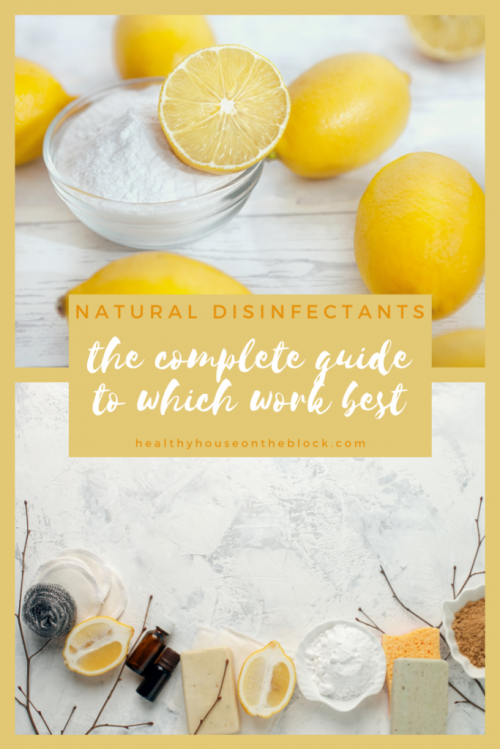
WHY NOT USE SYNTHETIC DISINFECTANTS?
Many of the ingredients in synthetic disinfectants are far from natural disinfectants. They’re man made and formulated out of chemicals and are extremely toxic to our human bodies. Not to mention, many synthetic disinfectants also use added fragrances to cover up the chemical and toxin odor in the product. We know that synthetic fragrances are extremely harmful to our endocrine system and reproductive system, and should be avoided.
Chlorine: Chlorine, commonly in bleach is used to kill most types of viruses and bacteria. However, it also causes problems with the respiratory system and has been linked to increased risk of asthma and allergies, especially in children. (STUDY)
Formaldehyde: As formaldehyde reacts as a bactericide and is often used in a steam form. Formaldehyde is a known carcinogen and extremely toxic to adults and especially children.
Phenols: Used as an antiseptic, disinfectant or preservative in disinfectant sprays and wipes. This synthetic disinfectant has been linked to reproductive harm, endocrine disruption and impaired neurodevelopment in children. (STUDY)
Quaternary Ammonium Compounds: A very common disinfectant ingredient for surfaces. However, it’s problematic in the sense that it causes problems in reproduction as well as birth defects. It’s also a skin irritant and contributes to our growing problems with asthma, especially in children.
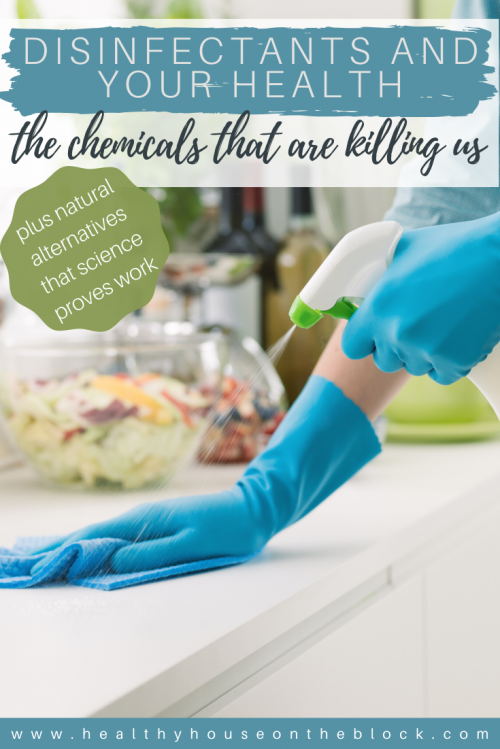
NATURAL DISINFECTANTS YOU CAN BUY
I personally have always been in the camp of buying my cleaners. I just feel more at ease buying a cleaner that is non-toxic and one that is a natural disinfectant as opposed to making one myself. I think it’s completely fine to make a natural disinfectant at home, but this is just what works best for my family. The natural disinfectant list below are some sprays you can buy from Target or Amazon. These two cleaners are also approved on the EPAs website as registered disinfectants.
- Seventh Generation Disinfecting Multi Surface Cleaner
- CleanWell Botanical Disinfectant
- Purchase on Amazon or through Thrive Marketplace
NATURAL DISINFECTANTS YOU CAN MAKE AT HOME
While I don’t usually disinfect with my own cleaners, in a pinch, these are some GREAT recipe options for disinfecting your home using products you have at home. Be cautious about what surface you use vinegar and/or hydrogen peroxide on, however, as they can either bleach or etch surfaces due to the high acidity.
Natural Disinfectant Recipe #1:
- 1 ½ cups 100 proof alcohol
- 50 drops of a disinfecting oil (Tea Tree, Lavender or Clove)
- 1 cup water
Natural Disinfectant Recipe #2:
- 1 ½ cups 70% Alcohol
- 1 tsp hydrogen peroxide
- 30 drops tea tree oil
- 15 drops lavender oil
- 1 cup water
Natural Disinfectant Recipe #3:
- 1 ¼ cups water
- ½ cup white vinegar
- ¼ cup 70% alcohol
- 15 drops lemon and lavender essential oil
- 1 cup water
